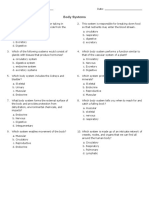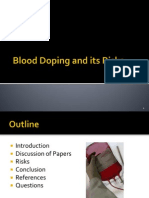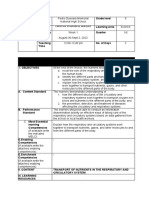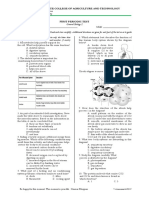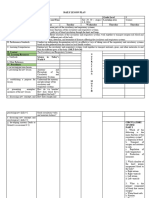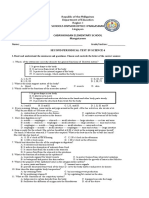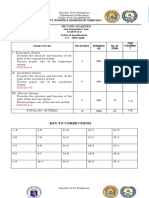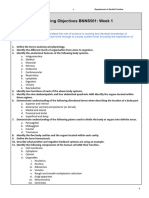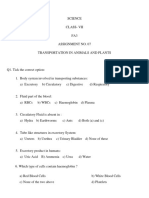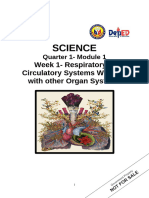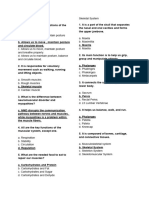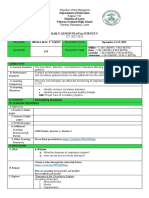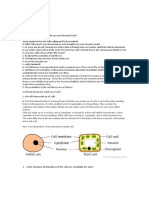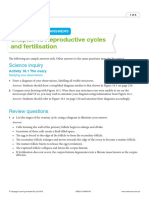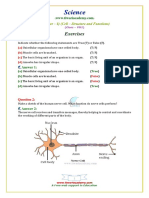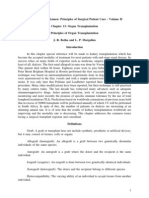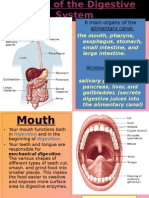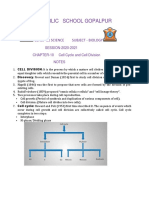Final Lesson Plan Day 6
Final Lesson Plan Day 6
Uploaded by
Sheila May Tapales TabonCopyright:
Available Formats
Final Lesson Plan Day 6
Final Lesson Plan Day 6
Uploaded by
Sheila May Tapales TabonOriginal Description:
Copyright
Available Formats
Share this document
Did you find this document useful?
Is this content inappropriate?
Copyright:
Available Formats
Final Lesson Plan Day 6
Final Lesson Plan Day 6
Uploaded by
Sheila May Tapales TabonCopyright:
Available Formats
Republic of the Philippines
Department of Education
Region VIII
Division of Leyte
Taberna National High School
Taberna, Palompon, Leyte
DAILY LESSON PLAN in SCIENCE 9
S.Y 2023-2024
TEACHER SHEILA MAY T. TABON TEACHING DATE September 5, 2023
QUARTER TEACHING TIME Anthurium – 7:40-8:40, Lavender – 8:40-9:40
First
Daisy – 1:00-2:00, Million – 2:00-3:00
I.OBJECTIVES
A. Content Standard The learners demonstrate understanding of...
The prevention, detection, and treatment of diseases affecting the circulatory and respiratory
systems
B. Performance Standard The learners should be able to...
Conduct an information dissemination activity on effective ways of taking care of the
respiratory and circulatory systems based on data gathered from the school or local health
workers.
C. Learning Competency explain how the respiratory and circulatory systems work together to transport nutrients,
gases, and other molecules to and from the different parts of the body (S9LT-la-b-26).
Identify the key parts of the circulatory system
Describe the function of each part of the circulatory system
II. CONTENT PARTS & FUNCTION OF THE CIRCULATORY SYSTEM
III. LEARNING RESOURCES
A. References
1.Teacher’s Guide pages
2. Learner’s Guide pages 11-15
3. Additional Learning Resources
ADM Module, Quarter 1– Module 1
(LR Portal)
4. Other Learning Resources Answer sheets, books
IV.PROCEDURE
A. Elicit REVIEW
What is the mechanism of breathing all about?
B. Engage
Choose from the words in the box which organs are involved in the circulatory systems.
MOUTH VEIN HEART TRACHEA STOMACH
BRONCHUS LIVER LUNGS NOSE ARTERY
CAPPILARY ALVEOLI BLOOD ESOPHAGUS ANUS
RECTUM LARYNX
C. Explore Explore the key parts of the circulatory system and its function and explore how the heart
works.
D. Explain CIRCULATORY SYSTEM
- The function of the circulatory system is to transport oxygen and nutrients to the
body cells and to carry deoxygenated (oxygen-poor) blood and carbon dioxide back
to the heart and lungs.
Major Parts
- Heart
- blood
- blood vessels
Blood Vessels: Pathways of Circulation
- arteries
- veins
- capillaries
E. Elaborate Activity: Let’s Organize!
Directions: Using the given concept map, fill in the missing parts, description, and functions
to complete the entire concept that you have learned in circulatory system.
F. Evaluating It’s Quiz Time!
Read the statement carefully and choose the letter of the correct answer.
1. Which blood vessel carries blood back to the heart?
a. Artery c. Capillary
b. Blood vessel d. Vein
2. Which part of the circulatory system, pumps the blood throughout the body?
a. Blood vessel c. blood
b. Heart d. artery
3. How many chambers are there in a human heart?
a. 1 b. 2 c. 3 d. 4
4. What type of circulation carries oxygenated blood to the body?
a. Bodily Circulation c. Pulmonary Circulation
b. Coronary Circulation d. Systemic Circulation
5. Which type of circulation refers to the movement of blood through the tissues
of the heart?
a. Bodily Circulation c. Pulmonary Circulation
b. Coronary Circulation d. Systemic Circulation
6. Which statement is true about the human circulatory system?
a. It makes blood cells.
b. It transports oxygen and nutrients.
c. It breaks down food and releases nutrients.
d. It is the first line of defense against bacteria
7. Which is NOT a function of the circulatory system?
a. Deliver oxygen and nutrients to cells.
b. Break down carbohydrates into glucose.
c. Transport other materials through body.
d. Remove carbon dioxide and wastes from cells.
8. Which blood vessel carries blood away from the heart?
a. Artery c. Capillary
b. Blood vessel d. Vein
9. Which blood vessel connects the smallest arteries to the smallest veins?
a. Artery c. Capillary
b. Blood vessel d. Vein
10. Which part of the circulatory system, carries the materials throughout the
body?
a. Blood vessel c. blood
b. Heart d. artery
G. Extend How does respiratory and circulatory systems work together?
Prepared by: Checked by:
SHEILA MAY T. TABON LIEZL EVE S. CARLOBOS
Teacher I Master Teacher I
You might also like
- Body Systems (Grade 6) - Free Printable Tests and Worksheets - HelpTeachingDocument1 pageBody Systems (Grade 6) - Free Printable Tests and Worksheets - HelpTeachingshuganesh82% (11)
- DAY: 4 I. Objectives: S9LT-lab-26Document6 pagesDAY: 4 I. Objectives: S9LT-lab-26GinalynMaacNo ratings yet
- Blood Doping PPT PresentationDocument26 pagesBlood Doping PPT Presentationee4254100% (1)
- Week 2-Day 2 I. Objectives: S9LT-lab-26Document5 pagesWeek 2-Day 2 I. Objectives: S9LT-lab-26GinalynMaacNo ratings yet
- Circulatory SystemDocument3 pagesCirculatory Systemamiel riveraNo ratings yet
- Day 4Document8 pagesDay 4cecilia.quatchon001No ratings yet
- Republic of The Philippines Region XII Southwest Alabel District Purok 12 Dacera, Domolok, Alabel Sarangani ProvinceDocument3 pagesRepublic of The Philippines Region XII Southwest Alabel District Purok 12 Dacera, Domolok, Alabel Sarangani ProvinceKristel Grace Rendon Gaviola-BaliolaNo ratings yet
- A Detailed Lesson Plan in Science 9Document5 pagesA Detailed Lesson Plan in Science 9GRACE LABATA0% (1)
- Cardio Lesson PlanDocument4 pagesCardio Lesson PlanAmiel Francisco Reyes100% (1)
- DLL Science Grade 6Document2 pagesDLL Science Grade 6Lady RuedaNo ratings yet
- LE WK1 2022 23 FinalDocument6 pagesLE WK1 2022 23 FinalCHRISTIAN STHEPHEN MARQUEZNo ratings yet
- Q2 Summative Test No.3 SCIENCEDocument4 pagesQ2 Summative Test No.3 SCIENCEMary Christine AlcantaraNo ratings yet
- First Periodic Test Biology IIDocument5 pagesFirst Periodic Test Biology IILeonel MendozaNo ratings yet
- 08Activity11LYMPHATICSYSTEMWORKSHEET PDFDocument4 pages08Activity11LYMPHATICSYSTEMWORKSHEET PDFYING FABIANA CHEN CASTRONo ratings yet
- Grade 7 Science Unit Test HumanbodyDocument4 pagesGrade 7 Science Unit Test HumanbodyKung ThanyathornNo ratings yet
- Life Processes NotesDocument10 pagesLife Processes NotesKarishmm KulkarniNo ratings yet
- Weekly Test in Science ViDocument2 pagesWeekly Test in Science ViIanRoseAcelajadoAderesNo ratings yet
- Part 6 Biological ScienceDocument5 pagesPart 6 Biological ScienceChester Kim DiscarNo ratings yet
- ScienceDocument34 pagesScienceKyle Dhiwell MarianoNo ratings yet
- DLL Gen Bio 5Document3 pagesDLL Gen Bio 5Bobby Arguilles PaboresNo ratings yet
- LP9th - Cardiovascular SystemDocument5 pagesLP9th - Cardiovascular SystemOliver VillanuevaNo ratings yet
- Department of Education Division of Leyte Taberna National High SchoolDocument4 pagesDepartment of Education Division of Leyte Taberna National High SchoolSheila May Tapales Tabon100% (1)
- Final Lesson Plan Day 2Document4 pagesFinal Lesson Plan Day 2Sheila May Tapales TabonNo ratings yet
- Science 9 Day 1Document7 pagesScience 9 Day 1ParmesanNo ratings yet
- Organ Systems Practice TestDocument8 pagesOrgan Systems Practice TestChristine RomanillosNo ratings yet
- Artlyn C. Fernando: Detailed Lesson Plan First QuarterDocument2 pagesArtlyn C. Fernando: Detailed Lesson Plan First QuarterJanet PagulayanNo ratings yet
- Croos Curricular ConnectionDocument4 pagesCroos Curricular Connectionwilbert quintuaNo ratings yet
- Science Form 3 - Chapter 3 - TransportationDocument6 pagesScience Form 3 - Chapter 3 - TransportationShatviga Visvalingam0% (1)
- A LESSON PLAN IN SCIENCE 6 CIRCULATORY SYSTEM Part2Document5 pagesA LESSON PLAN IN SCIENCE 6 CIRCULATORY SYSTEM Part2Thine Aliyah Robea Gayapa100% (1)
- First Quarter Test in Grade 9 Science: Caraga Administrative RegionDocument3 pagesFirst Quarter Test in Grade 9 Science: Caraga Administrative RegionCary Clark OriasNo ratings yet
- nATG 6 ReviewrDocument16 pagesnATG 6 ReviewrMERRYLOS CABALSANo ratings yet
- DLP Circulatory SystemDocument7 pagesDLP Circulatory Systemalexandravasquez.sciencenorthNo ratings yet
- Lesson-Plan CirculationDocument6 pagesLesson-Plan Circulationbenaventestephen1No ratings yet
- INSTRUCTIONS: Read The Following Questions Comprehensively. Be Wary of The Options, Choose Only The Best. ONLY THEDocument2 pagesINSTRUCTIONS: Read The Following Questions Comprehensively. Be Wary of The Options, Choose Only The Best. ONLY THEKristine Ibarreta-JazulNo ratings yet
- 2ND Periodic Test in Science 6Document6 pages2ND Periodic Test in Science 6Ruth Ann Ocsona Laoag100% (1)
- TVI Lesson PlanDocument6 pagesTVI Lesson PlanRobelle RelativoNo ratings yet
- Hybrid Science 9 Q1 V3Document74 pagesHybrid Science 9 Q1 V3Aisha LouiseNo ratings yet
- Unit I. Unit II. Cells, Tissues, Glands and MembranesDocument3 pagesUnit I. Unit II. Cells, Tissues, Glands and MembranesIkea BalhonNo ratings yet
- Science9 - q1 - Module1 - Respiratoryandcirculatorysystemsworkingtogether v2.0Document26 pagesScience9 - q1 - Module1 - Respiratoryandcirculatorysystemsworkingtogether v2.0Twela Dea Dela CruzNo ratings yet
- 2nd Quarter Science Exam NIYES Grade 6Document6 pages2nd Quarter Science Exam NIYES Grade 6JeiSon JuanNo ratings yet
- Science-9 Q1 Mod1 Respiratory-And-Circulatory-System VerFinal ANSWEREDDocument35 pagesScience-9 Q1 Mod1 Respiratory-And-Circulatory-System VerFinal ANSWEREDvonneivan26No ratings yet
- TOS and Test in Science 9 1st MonthlyDocument5 pagesTOS and Test in Science 9 1st MonthlySher SherwinNo ratings yet
- Summative Test in Science NAME: - Grade: Date: - SCORE - Learning OutcomesDocument4 pagesSummative Test in Science NAME: - Grade: Date: - SCORE - Learning OutcomesS BasriNo ratings yet
- Lifting of Answers From The Internet Is Considered ZeroDocument14 pagesLifting of Answers From The Internet Is Considered ZeroBelinda Viernes100% (1)
- 2ND Summ-Q2Document3 pages2ND Summ-Q2chona redillasNo ratings yet
- August 26, 2022Document4 pagesAugust 26, 2022Melanie CoronaNo ratings yet
- Understanding The Human Body SystemsDocument7 pagesUnderstanding The Human Body Systemsines.ramos.irgNo ratings yet
- Week 1 Learning ObjectivesDocument2 pagesWeek 1 Learning ObjectiveslilybryantnzNo ratings yet
- Grade VI Pre NAT 1Document5 pagesGrade VI Pre NAT 1gineflor abelidoNo ratings yet
- TCDocument4 pagesTCPrecious Jancine Darisan MoralNo ratings yet
- Second Periodic Test in Science 6Document5 pagesSecond Periodic Test in Science 64knnwnrjkhNo ratings yet
- Answer Key - WS-1Document6 pagesAnswer Key - WS-1dwolf3639No ratings yet
- Anatomy and Physiology (LECTURE) QuizzesDocument18 pagesAnatomy and Physiology (LECTURE) QuizzesKore ProserpinaNo ratings yet
- Strictly No Erasures.: 1St Long Quiz /// Practical Nursing /// Module 1 and Module 2 /// Set ADocument7 pagesStrictly No Erasures.: 1St Long Quiz /// Practical Nursing /// Module 1 and Module 2 /// Set AOneLove 2ShopNo ratings yet
- 3rd Quarter Examination in ScienceDocument8 pages3rd Quarter Examination in ScienceMyla LuayNo ratings yet
- PT - Science 6 - Q2Document9 pagesPT - Science 6 - Q2Bāby Lyn Maraño TalagtagNo ratings yet
- CBSE Class 7 Science Worksheet (7) - 0Document4 pagesCBSE Class 7 Science Worksheet (7) - 0Yatish TiwariNo ratings yet
- Science: Week 1-Respiratory and Circulatory Systems Working With Other Organ SystemsDocument29 pagesScience: Week 1-Respiratory and Circulatory Systems Working With Other Organ SystemslyracastrocteNo ratings yet
- SystemDocument2 pagesSystemlaynojannamarizxNo ratings yet
- Exams - Anatomy and Physiology (Pp1)Document4 pagesExams - Anatomy and Physiology (Pp1)emmabitutu5No ratings yet
- Anatomy and Physiology: The Lymphatic System: Things You Should Know (Questions and Answers)From EverandAnatomy and Physiology: The Lymphatic System: Things You Should Know (Questions and Answers)No ratings yet
- Final Lesson Plan Day 2Document4 pagesFinal Lesson Plan Day 2Sheila May Tapales TabonNo ratings yet
- Department of Education Division of Leyte Taberna National High SchoolDocument6 pagesDepartment of Education Division of Leyte Taberna National High SchoolSheila May Tapales TabonNo ratings yet
- Department of Education Division of Leyte Taberna National High SchoolDocument5 pagesDepartment of Education Division of Leyte Taberna National High SchoolSheila May Tapales TabonNo ratings yet
- Department of Education Division of Leyte Taberna National High SchoolDocument4 pagesDepartment of Education Division of Leyte Taberna National High SchoolSheila May Tapales Tabon100% (1)
- Department of Education Division of Leyte Taberna National High SchoolDocument5 pagesDepartment of Education Division of Leyte Taberna National High SchoolSheila May Tapales TabonNo ratings yet
- Department of Education Division of Leyte Taberna National High SchoolDocument3 pagesDepartment of Education Division of Leyte Taberna National High SchoolSheila May Tapales TabonNo ratings yet
- Science 9 ActivityDocument4 pagesScience 9 ActivityKATHY CLAIRE BALLEGANo ratings yet
- Comic StripDocument2 pagesComic StripSatori TendōNo ratings yet
- Anatomy - Physiology (Chapter 1 - The Human Organism)Document16 pagesAnatomy - Physiology (Chapter 1 - The Human Organism)Avi ZychNo ratings yet
- Anatomy and Physiology Module 8aDocument11 pagesAnatomy and Physiology Module 8aJayR MendonesNo ratings yet
- Chapter 16 AnswersDocument6 pagesChapter 16 AnswersindapantsNo ratings yet
- Biology 1: Cell Theory Cell Structure and FunctionsDocument4 pagesBiology 1: Cell Theory Cell Structure and FunctionsEmilio Villafria IVNo ratings yet
- 8 Science NCERT Solutions Chapter 8Document6 pages8 Science NCERT Solutions Chapter 8Raj AnandNo ratings yet
- Lit Ing-4Document4 pagesLit Ing-4omansukiman097No ratings yet
- Anatomy and Physiology With Integrated Study Guide. Anatomy and Physiology With Integrated Study Guide 6th Edition ISBN 9780078097294, 978-0078097294Document23 pagesAnatomy and Physiology With Integrated Study Guide. Anatomy and Physiology With Integrated Study Guide 6th Edition ISBN 9780078097294, 978-0078097294candacenealygjs100% (15)
- Oral Mucosa DiagramsDocument8 pagesOral Mucosa DiagramsAysha100% (1)
- C. J. Mieny, U. Mennen: Principles of Surgical Patient Care - Volume II Chapter 13: Organ Transplantation Principles of Organ Transplantation J. R. Botha and L. P. MargoliusDocument28 pagesC. J. Mieny, U. Mennen: Principles of Surgical Patient Care - Volume II Chapter 13: Organ Transplantation Principles of Organ Transplantation J. R. Botha and L. P. MargoliusGordana UzelacNo ratings yet
- Cervical and Shoulder 2020Document14 pagesCervical and Shoulder 2020Eduardo OlivaNo ratings yet
- Week 8 Anph111 MidtermDocument17 pagesWeek 8 Anph111 MidtermCASTRO, ANDREI KARL Z.No ratings yet
- Fcps Past Papers PartDocument25 pagesFcps Past Papers PartBeena Muhammad Fahad100% (1)
- Organs of The Digestive SystemDocument16 pagesOrgans of The Digestive SystemBrandon HunterNo ratings yet
- Army Public School Gopalpur: Class - 11 Science Subject - BiologyDocument6 pagesArmy Public School Gopalpur: Class - 11 Science Subject - BiologyAshok KumarNo ratings yet
- Immunologic Tolerance AND AutoimmunityDocument22 pagesImmunologic Tolerance AND AutoimmunityTenunBagusDariNttNo ratings yet
- Oral Mucous Membrane - Complete Denture PatientDocument84 pagesOral Mucous Membrane - Complete Denture PatientyabhatiaNo ratings yet
- Arteries of The Head and NeckDocument23 pagesArteries of The Head and NeckFatima Kh SalahNo ratings yet
- Muscular System Quiz 01 - Attempt ReviewDocument13 pagesMuscular System Quiz 01 - Attempt ReviewPsalm Jirehmae SantosNo ratings yet
- Glandular EpitheliumDocument10 pagesGlandular EpitheliumAbby Claire SomeraNo ratings yet
- HES 006 Lec Session #1 - SASDocument5 pagesHES 006 Lec Session #1 - SASTam BeloNo ratings yet
- I. Objectives A. Content Standards: Monday Tuesday Wednesday Thursday FridayDocument8 pagesI. Objectives A. Content Standards: Monday Tuesday Wednesday Thursday FridayMaribel NayadNo ratings yet
- Artificial Hybridisation MCQDocument6 pagesArtificial Hybridisation MCQKartik Gaming 2.0No ratings yet
- 4.recent Advancement in Infertility TreatmentDocument23 pages4.recent Advancement in Infertility TreatmentVeena DalmeidaNo ratings yet
- Attachment For Week 4 Melc 5Document3 pagesAttachment For Week 4 Melc 5Caryl Ann C. SernadillaNo ratings yet
- Table of Specification in 1GEN BIO 1STDocument3 pagesTable of Specification in 1GEN BIO 1STLouie DenostaNo ratings yet
- CBSE 8, Science, CBSE - Cell Structure and Functions, MCQDocument3 pagesCBSE 8, Science, CBSE - Cell Structure and Functions, MCQR.Shruti 1040-12No ratings yet
- The - Skeletal - System Lab ActDocument13 pagesThe - Skeletal - System Lab Actwelfred indinoNo ratings yet
